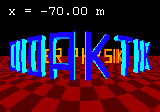 Hannover 2016 horizontal view |
Internet ProjectTransit of Mercury, May 9th, 2016 |
 Hannover 2016 equatorial view |

Lots of material (images, position measurements, tables of measured positions of Mercury) have been uploaded by the participants of this project. They allowed not only to visualize the parallax effect of Mercury but also to measure its size and to determine the distance to the Sun, i. e. the Astronomical Unit. During the process the participants could reproduce with modern equipment the historically first exact method of measuring the solar parallax and experience the related requirement of exact preparation, measurement and evaluation.
We got our best result for the Astronomical Unit by comparing series of pictures taken in California, France, Germany, Namibia, Poland, Spain and Venezuela:
The results are presented in detail in our Project Results.
Some of the participants of our recent projects IYA2009 - Shape of the Earth and IYA2009 - Distance to the Moon and Transit of Venus 2012 and a group of German teachers will repeat the observations and measurements done during the transit of Venus trying to make the parallax of Mercury visible and - perhaps - to determine the distance to the sun.
We don't plan to repeat the transit project of 2012 in detail. But we try to bring interested people into contact and offer here the possibilitiy to exchange photos and the results of position measurements via our data exchange pages.
People (pupils, teachers, amateurs and professional astronomers who are interested in systematically observing and evaluating the transit of Mercury are invited to join us by contacting the editor of this page.
The conditions of visibility will be very similar to those of the transits of Mercury in 2003 and of Venus in 2004.
| The daylight side of the earth when the transit ... | |
|---|---|
 |
 |
| ... starts (11:10 UT) | ... ends (18:45 UT) |
| The images show the locations of our actual participants. | |
The circumstances of the transit are described in detail by Fred Espanak. Local circumstances can be predicted by using the transit calculators of Xavier M. Jubier or J. Giesen.
The course of this transit (and other eclipses and transits) as seen from arbitrary locations on earth can be visualized with the Windows program Finsternisse or its English version Eclipses. The pictures below have been calculated with that program.
But the Mercury's parallax effect will be much smaller than that of Venus:
 |
 |
 |
||
|---|---|---|---|---|
| Hannover, Germany, 16:00 UT | Cape Town, South Africa, 16:00 UT | Parallax Hannover-Cape Town, 16:00 UT |
The largest effect can perhaps simultaneously be observed from Helsinki, Finland, and Buenos Aires, Argentina:
 |
|---|
| Parallax Helsinki-Buenos Aires |
The basic ideas of observing and evaluating the transit are described in an additional paper in an English version and a German version.

|

|
Editor: | Udo Backhaus |
last update: 10.08.2016 |

|